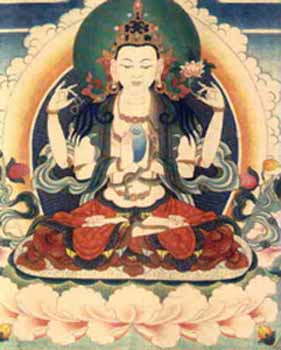TIBETAN BUDDHISM

Tibetan Buddhism, also called LAMAISM, distinctive form of Buddhism
that evolved from the 7th century AD in Tibet. It is based mainly on the rigorous intellectual disciplines of Madhyamika and
Yogacara philosophy and utilizes the symbolic ritual practices of Vajrayana (Tantric Buddhism). Tibetan Buddhism also incorporates
the monastic disciplines of early Theravada Buddhism and the shamanistic features of the indigenous Tibetan religion, Bon.
Characteristic of Tibetan Buddhism is the unusually large segment
of the population actively engaged in religious pursuits (up until the Chinese communist takeover of the country in the 1950s
an estimated one-quarter of the inhabitants were members of religious orders); its system of "reincarnating lamas"; the traditional
merger of the spiritual and temporal authority in the office and person of the Dalai Lama; and the vast number of divine beings
(each with its own family, consort, and pacific and terrifying aspects), which are considered symbolic representations of
the psychic life by the religiously sophisticated and accepted as realities by the common people.
Buddhism was transmitted into Tibet mainly during the 7th to 10th
centuries. Notable early teachers were the illustrious 8th-century Tantric master Padmasambhava and the more orthodox Mahayana
teacher Santiraksita.
With the arrival from India in 1042 of the great teacher Atisa, a
reform movement was initiated, and within a century the major sects of Tibetan Buddhism had emerged. The Dge-lugs-pa, or One
of the Virtuous System, commonly known as the Yellow Hats, the order of the Dalai and the Panchen Lamas, has been the politically
predominant Tibetan sect from the 17th century until 1959, when the hierocratic government of the Dalai Lama was abolished
by the People's Republic of China.
By the 14th century the Tibetans had succeeded in translating all
available Buddhist literature in India and Tibet; many Sanskrit texts that have since been lost in the country of their origin
are known only from their Tibetan translations. The Tibetan canon is divided into the Bka'-'gyur, or Translation of the Word,
consisting of the supposedly canonical texts, and the Bstan-'gyur, or Transmitted Word, consisting of commentaries by Indian
masters.
In the second half of the 20th century Tibetan Buddhism spread to
the West, particularly after the subjugation of Tibet to Chinese Communist rule sent many refugees, including highly regarded
"reincarnated lamas," or tulkus, out of their homeland. Tibetan religious groups in the West include both communities of refugees
and those consisting largely of occidentals drawn to the Tibetan tradition.

